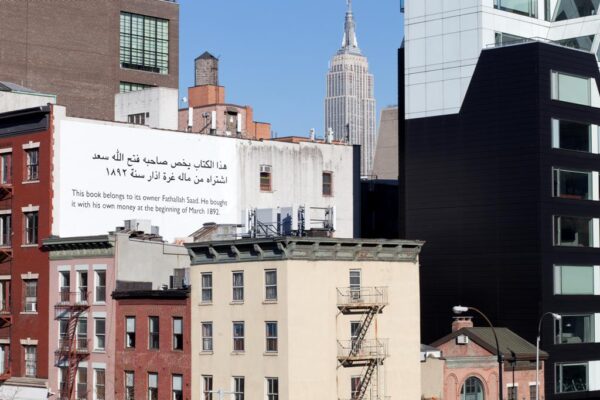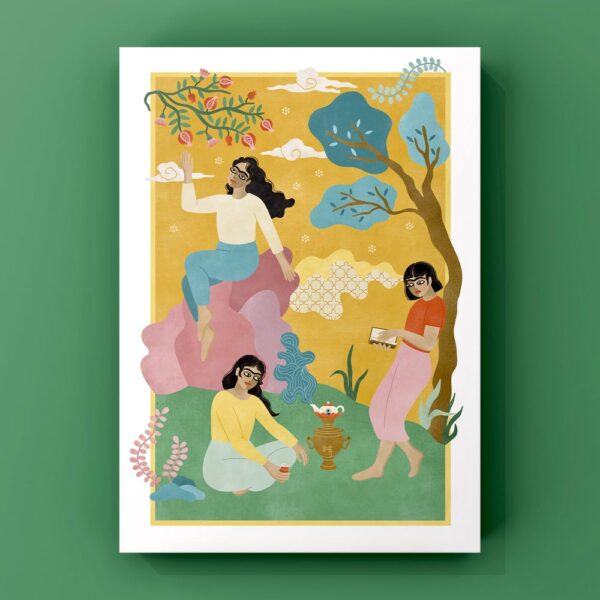Artists play a huge role in carrying and forming new narratives. Especially within the Middle East and its diaspora– a region usually studied only in an art historical context– contemporary artists bring significant symbolism to their work within larger political discourses. The artists featured below cover both young and well established practitioners, representing a wide variety of mediums.
Furthermore, art organizations also play a large role in the Middle East, particularly in the diaspora. Art is an excellent medium to connect diasporas throughout the globe, and these following organizations curate a multimedia perspective of the region. From selling products to creating community, art organizations are a key part of unity for the Middle East.
Featured image credit: Mariam Tafsiri
ARTISTS
Nezaket Ekici

Nezaket Ekici (personal website in German/English) is a German-Turkish performance and multimedia artist who broadly uses her dual identities in her performances, videos and installations. The subjects Ekici deals with are related to time, movement, space, material, body, and action and interaction. She uses her body as a means of expression and investigation, and always keeps her works in the context with the audience. Her aim is to create a situation in which all elements are connected together to form a whole work of art, a concept known as Gesamtkunstwerk. She has presented more than 150 different performances in over 40 countries, connecting with more than 120 cities on 4 continents.
More resources on Ekici:
- Braverman Gallery Artist Profile
- Nezaket Ekici Instagram
- YouTube: Nezaket Ekici | Work In Progress – Personal Map (2020)
Emily Jacir

Emily Jacir is a Palestinian-American mutli-media artist. Her work spans film, photography, installation, performance, video, writing, and sound. She draws on the artistic medium of concept art and social intervention as a framework for her pieces, in which she focuses on themes of displacement, exile, and resistance, primarily within the context of Palestinian occupation. Widely exhibited throughout the world, Jacir has also worked to build community in and around the Middle East arts scene: she founded and curated the first International Video Festival in Ramallah in 2002. She was awarded the prestigious Biennial Hugo Boss Prize in 2008 for her work, which the judges recognized as “poignant and memorable,” as well as “intensely personal and deeply political.” The prize included $100,000 and a solo exhibition of her work at the Guggenheim Museum in New York.
About the ex libris project – seen above, Ms. Jacir shared the following with Hive Voices in 2014:
There are several different paths that led me to ex libris. One was the research I was doing on the situation in Mamilla Cemetery in Jerusalem. This cemetery is going to be the site of a facility called the “Museum of Tolerance” being built by the Simon Wiesenthal Center of Los Angeles in partnership with the Israeli government. Part of the cemetery is being destroyed, and hundreds of human remains desecrated. It has been a burial ground since the 7th century. Before that, it was the site of a Byzantine church. Generations of Jerusalem families are buried there. I was on the site a lot, photographing the various monuments, gravestones and other structures, like the ancient pool there. During the British Mandate it was declared a historical site and later an antiquities site. In conjunction with this research, there were site visits to Kassel (in Germany) and especially the visit to the Murhard library, where the librarian spoke to us about the books that were destroyed when the Fridericianum, housing the library of the Land- graves of Hesse-Kassel, was bombed in 1941. He also showed us the remains of books that were severely damaged but had survived. “Sixty to eighty bombs hit the Fridericianum, but not one bomb hit the tower,” he said, and this really stuck in my mind. The manuscripts that were hidden in the tower survived. I was also doing a lot of research on the Hesse region during the period when it belonged to the American zone of occupation. In particular, I was absolutely fascinated by the work of the Monuments, Fine Arts and Archives officers and their efforts at the Offenbach Archival Depot, where the biggest book restitution project in history took place. On May 1, 1946 Offenbach was designated as the “sole archival depot” in the American zone of occupation for the handling of looted books and archives.
I first learned about the A.P. books (Abandoned Property books in the Jewish National Library in Jerusalem) in 2008 from an article I read by Gish Amit. It was published in the Jerusalem Quarterly, under the title: “Ownerless Objects? The story of the books Palestinians left behind in 1948.” After that, one of my closest and dearest friends Munir Fakher Eldin and I spent many long hours together at the library and in deep discussions regarding the books. Our talks revolved around the idea of custodianship, preservation, restitution and the relationship between books and land, especially “Absentee Property.” Munir, who is an academic, pointed to what these books have meant to generations of Israeli scholars, and how the library not only acts as a host for these books, but utilizes them as intellectual property.
For more on Emily Jacir:
Desire in Diaspora: Emily Jacir (San Francisco Museum of Modern Art profile, 2008)
Lamia Joreige

Born in Beirut in 1972, Lamia Joreige is a visual artist and filmmaker. She uses archival documents and elements of fiction to reflect on history and its possible narration, and on the relationship between individual stories and collective memory. Her creative process is rooted in her country’s experience, and she explores the possibilities of representing the Lebanese wars and their aftermath. Her work considers the concept of time, how time and events are preserved, and how these moments affect us.
This drawing is part of a multi-year, multimedia project entitled Under-Writing Beirut—Ouzai that entailed digital prints, texts, drawings and scultpture focused on the evolution of area south of Beirut. About the project, Joreige writes on her website:
Under-Writing Beirut takes up the histories and dynamics of Ouzaï. For a long time, this area south of Beirut known as Roumoul (the dunes) was unoccupied and undefined. In the 1950s, as the city outgrew its ramparts, the land on its edges, useless for agriculture, became more valuable. The southern suburbs saw some substantial state investment as part of a growing, modernizing metropolis.
The first inhabitants of Ouzaï were almost all rural Lebanese driven towards Beirut by a changing economy. From the nineteenth century onward, the continual lack of legal clarity over the ownership of land in Ouzaï allowed the tension to fester in the 50s, culminating in a trial, where it was finally decided that the land was private and not owned by the municipality of Bourj al Brajneh. This caused a spurt of informal (and, according to the trial’s decision, illegal) construction. The contested ownership, along with the weak regulatory power of the state and the fact that many properties were owned by a large number of co-owners, created a favorable ground for people who, looking for a better life near the capital or later fleeing the violence of the war, would settle there, most of them illegally.
The period preceding and during the Lebanese war saw a radical transformation of the area. The regular bombarding and then invasion of the southern villages of Lebanon by Israel led to the displacement of thousands of villagers, mainly Shias. Many of them first settled in Beirut’s eastern suburbs, before they were forced to flee again during the civil war, which led to the partition of the capital. They then settled in the southern suburbs of the city, now commonly called ‘Dahiye’. As a result, the area saw the solidification of a Shia community, and a densification of informal, mainly illegal constructions in Ouzaï.
Today, the area is more heterogeneous than the common monolithic understanding of ‘Dahiye’ implies. Indeed, Ouzaï is a small area, which carries its own history, but somehow it encompasses the quintessence of what is facing all of Lebanon right now – issues of sectarian division, displacement, community, urban transformation, density of construction, inequality, reconciliation. What real or imagined narratives such a space triggers? How might art transcend or think outside of both stigmatizing and accusatory rhetorics?
The drawings Coastline are based on the topography of Ouzaï’s coastline in maps. The sand casted sculpture Ouzaï is inspired from and based on the mapping of the streets that constitute this area today, most of them were made without formal planning, in flux, often defined by rapid construction. Based on aerial photographs from the Lebanese Military and Zoom Earth, Ouzaï, Cartography of a Transformation propose a subjective, poetic visual interpretation of the transformation of Ouzaï over the years, from a sandy coastal mostly uninhabited area to a densely built and populated one. That history is narrated in A Brief History of Ouzaï through my encounters with several members and acquaintances of the Nasser family who were pioneer settlers in the 50s, depicting mundane and historic places that are enmeshed with the narratives of this area.
Visit the artist’s website to explore more of her work.
Mariam Tafsiri

Mariam Tafsiri is a British-Iranian illustration artist currently living in London. Her illustrations draw on inspirations from Persian Qajar art, miniature paintings, and Islamic designs. Her interest in Qajar art developed at an early age, sparking interest from the unibrowed women who present a very different concept of beauty to that regularly portrayed in the West.
Follow Mariam’s creations at her Instagram acccount.
Organizations
Coming soon
Collectives

